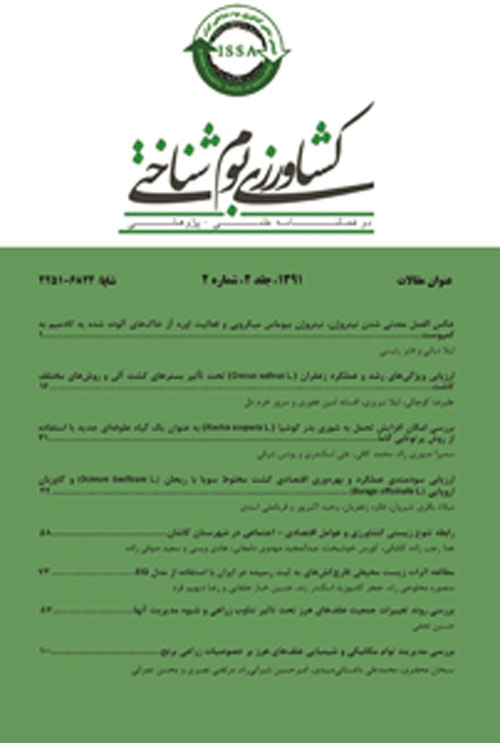Evaluation of energy indices and global warming potential for rice systems in the first and second planting patterns (Case study: Sari city)
Author(s):
Abstract:
Introduction
Cereals are the dominant crops in world agriculture and are the major source of calories and protein to the diets of humans and livestock. Rice (Oryza sativa L.) is the second most important cereal in the world and it is is generally considered a semi-aquatic annual plant. The growth period of rice varied from 2-8 months, depending on the variety and environmental conditions with two distinct phases, namely vegetative and reproductive (including ripening). The dependence of conventional agricultural systems to intensive using of inputs and energy is one of the main reasons creating environmental impacts such as climate change, eutrophication, acidification and global warming. Effective use of energy resources in agriculture is one of the principal requirements for sustainable development; it will minimize environmental problems, prevent destruction of natural resources and promote sustainable agriculture as an economical production. Energy consumption in agriculture has been increasing in response to the limited supply of arable land, increasing population and a desire for higher standards of living (Karkacier and Gokalp Goktolga, 2005; Kizilaslan, 2009; Smil, 2008).Materials And Methods
This study was conducted to study the energy indices and global warming potential of rice at the first and second planting patterns in Sari city through a questionnaire conducted during 2014. Inputs and outputs were converted to energy values using coefficients and the indices studied included the input energy (IE), output energy (OE), energy use efficiency (EUE), energy productivity (EP), special energy (SE), net energy (NE), direct energy (DE), indirect energy (IE), renewable energy (RE), non-renewable energy (NE) and global warming potential (GWP) of rice at the first and the second planting patterns. Cronbach's alpha coefficient was calculated as a tool for the reliability assessment.Results And Discussion
Cronbach's alpha coefficient for the questionnaire was calculated as equal to α=%85. The results showed that input energy for the first and second planting patterns was 55332 and 56858 MJ ha-1 and their output energy was 80377 and 48926 MJ ha-1, respectively. Energy use efficiency and net energy for the first planting pattern were calculated as 1.45 and 24945 MJ ha-1 and, at the second planting pattern, these energy indices declined to 0.86 and -7923 MJ ha-1, respectively. Energy productivity in the first planting was calculated at 0.07 kg MJ-1 and it was 0.04 kg MJ-1 for the second planting. Special energy was 13.83 and 23.89 MJ kg-1, respectively, in the first and second patterns. The first planting pattern was more efficient in terms of energy consumption than the second pattern which was related to inputs and paddy yield. The global warming potential for the first and second planting patterns was computed as 990 and 1187 kg equiv. CO2 ha-1, respectively. Global warming potential for these planting patterns was 248 and 498 kg equiv. CO2 per t paddy yield, respectively.Conclusion
Energy analysis of rice in the first and second planting patterns showed that input energy in the first planting pattern was lower than in the second pattern, but paddy yield in the first planting pattern was higher than in the other planting pattern. Both energy efficiency and productivity for the second pattern are low. The global warming potential in the second crop planting was higher than in the first planting pattern which was due to the consumption of inputs and energy. Keywords:
Language:
Persian
Published:
Journal of Agroecology, Volume:6 Issue: 2, 2017
Page:
227
magiran.com/p1680998
دانلود و مطالعه متن این مقاله با یکی از روشهای زیر امکان پذیر است:
اشتراک شخصی
با عضویت و پرداخت آنلاین حق اشتراک یکساله به مبلغ 1,390,000ريال میتوانید 70 عنوان مطلب دانلود کنید!
اشتراک سازمانی
به کتابخانه دانشگاه یا محل کار خود پیشنهاد کنید تا اشتراک سازمانی این پایگاه را برای دسترسی نامحدود همه کاربران به متن مطالب تهیه نمایند!
توجه!
- حق عضویت دریافتی صرف حمایت از نشریات عضو و نگهداری، تکمیل و توسعه مگیران میشود.
- پرداخت حق اشتراک و دانلود مقالات اجازه بازنشر آن در سایر رسانههای چاپی و دیجیتال را به کاربر نمیدهد.
In order to view content subscription is required
Personal subscription
Subscribe magiran.com for 70 € euros via PayPal and download 70 articles during a year.
Organization subscription
Please contact us to subscribe your university or library for unlimited access!


